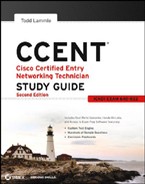Contents
Advantages of Reference Models
Half- and Full-Duplex Ethernet
Ethernet at the Data Link Layer
Ethernet at the Physical Layer
Written Lab 1.1: OSI Questions
Written Lab 1.2: Defining the OSI Layers and Devices
Written Lab 1.3: Identifying Collision and Broadcast Domains
Written Lab 1.4: Binary/Decimal/Hexadecimal Conversion
The Process/Application Layer Protocols
The Host-to-Host Layer Protocols
The Hierarchical IP Addressing Scheme
Chapter 3 IP Subnetting, Troubleshooting IP, and Introduction to NAT
Classless Inter-Domain Routing (CIDR)
Determining IP Address Problems
Introduction to Network Address Translation (NAT)
Types of Network Address Translation
Written Lab 3.1: Written Subnet Practice #1
Written Lab 3.2: Written Subnet Practice #2
Written Lab 3.3: Written Subnet Practice #3
Chapter 4 Cisco's Internetworking Operating System (IOS)
Gathering Basic Routing Information
Router and Switch Administrative Configurations
Setting Interface Descriptions
Configuring an IP Address on an Interface
Viewing, Saving, and Erasing Configurations
Deleting the Configuration and Reloading the Router
Hands-on Lab 4.1: Erasing an Existing Configuration
Hands-on Lab 4.2: Exploring User, Privileged, and Configuration Modes
Hands-on Lab 4.3: Using the Help and Editing Features
Hands-on Lab 4.4: Saving a Router Configuration
Hands-on Lab 4.5: Setting Passwords
Hands-on Lab 4.6: Setting the Hostname, Descriptions, IP Address, and Clock Rate
Chapter 5 Managing a Cisco Internetwork
The Internal Components of a Cisco Router
Managing Configuration Register
Understanding the Configuration Register Bits
Checking the Current Configuration Register Value
Changing the Configuration Register
Backing Up and Restoring the Cisco IOS
Restoring or Upgrading the Cisco Router IOS
Using the Cisco IOS File System (Cisco IFS)
Backing Up and Restoring the Cisco Configuration
Backing Up the Cisco Router Configuration
Restoring the Cisco Router Configuration
Using the Cisco IOS File System to Manage Your Router's Configuration (Cisco IFS)
Using Cisco Discovery Protocol
Getting CDP Timers and Holdtime Information
Gathering Neighbor Information
Gathering Interface Traffic Information
Gathering Port and Interface Information
Documenting a Network Topology Using CDP
Telnetting into Multiple Devices Simultaneously
Checking and Troubleshooting Network Connectivity
Using the show processes Command
Hands-on Lab 5.1: Backing Up Your Router IOS
Hands-on Lab 5.2: Upgrading or Restoring Your Router IOS
Hands-on Lab 5.3: Backing Up the Router Configuration
Hands-on Lab 5.4: Using the Cisco Discovery Protocol (CDP)
Hands-on Lab 5.5: Using Telnet
Hands-on Lab 5.6: Resolving Hostnames
Testing Your IP Routing Understanding
Configuring IP Routing in the Network
Distance-Vector Routing Protocols
Verifying the RIP Routing Tables
Configuring RIP Routing Example 2
Enabling RIPv2 on the Internetwork
Hands-on Lab 6.1: Creating Static Routes
Hands-on Lab 6.2: Configuring RIP Routing
Limitations of Layer 2 Switching
Three Switch Functions at Layer 2
Chapter 8 Wireless Technologies
Introducing Wireless Technology
SSIDs, WEP, and MAC Address Authentication
Mitigating Password, Router, and Switch Attacks
Chapter 10 Introduction to Wide Area Networks
Introduction to Wide Area Networks
Data Terminal Equipment and Data Communication Equipment
High-Level Data-Link Control (HDLC) Protocol
Configuring PPP on Cisco Routers
Configuring PPP Authentication
Hands-on Lab 10.1: Configuring PPP Encapsulation and Authentication
Hands-on Lab 10.2: Configuring and Monitoring HDLC
Appendix A Answers to Written Labs
Chapter 3: IP Subnetting, Troubleshooting IP, and Introduction to NAT
Chapter 4: Cisco's Internetworking Operating System (IOS)
Chapter 5: Managing a Cisco Internetwork
Chapter 8: Wireless Technologies
Chapter 10: Introduction to Wide Area Networks
Appendix B Answers to Review Questions
Chapter 3: IP Subnetting, Troubleshooting IP, and Introduction to NAT
Chapter 4: Cisco's Internetworking Operating System (IOS)
Chapter 5: Managing a Cisco Internetwork
Chapter 8: Wireless Technologies
Chapter 10: Introduction to Wide Area Networks
